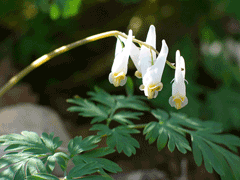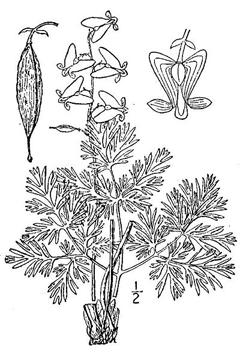 |
|
|
 |
| USDA-NRCS PLANTS Database / Britton, N.L., and A. Brown. 1913. Illustrated flora of the northern states and Canada. Vol. 2: 142.Dicentra spectabilis |
Translate this page:
Summary
Bloom Color: Pink, White.
Main Bloom Time: Early spring. Form: Irregular or sprawling.
Physical Characteristics

 Dicentra cucullaria is a PERENNIAL growing to 0.1 m (0ft 4in) by 0.3 m (1ft) at a medium rate.
Dicentra cucullaria is a PERENNIAL growing to 0.1 m (0ft 4in) by 0.3 m (1ft) at a medium rate.
See above for USDA hardiness. It is hardy to UK zone 5. It is in flower in May. The species is hermaphrodite (has both male and female organs) and is pollinated by Bees.
Suitable for: light (sandy) and medium (loamy) soils. Suitable pH: mildly acid and neutral soils. It can grow in full shade (deep woodland) or semi-shade (light woodland). It prefers moist soil.
UK Hardiness Map
US Hardiness Map
Synonyms
Plant Habitats
Woodland Garden Dappled Shade; Shady Edge; not Deep Shade;
Edible Uses
References More on Edible Uses
Medicinal Uses
Plants For A Future can not take any responsibility for any adverse effects from the use of plants. Always seek advice from a professional before using a plant medicinally.
Alterative Diaphoretic Diuretic Poultice Tonic VD
Alterative, tonic[46, 61]. The dried tubers were used as a tonic and were recommended in the treatment of VD[213]. A tea made from the roots is diaphoretic and diuretic[222]. A poultice made from the leaves has been used in the treatment of skin ailments and as a muscle rub to make them more limber[222]. The plant contains an alkaloid that depresses the central nervous system - it is used in the treatment of paralysis and tremors[222].
References More on Medicinal Uses
The Bookshop: Edible Plant Books
Our Latest books on Perennial Plants For Food Forests and Permaculture Gardens in paperback or digital formats.

Edible Tropical Plants
Food Forest Plants for Hotter Conditions: 250+ Plants For Tropical Food Forests & Permaculture Gardens.
More

Edible Temperate Plants
Plants for Your Food Forest: 500 Plants for Temperate Food Forests & Permaculture Gardens.
More

More Books
PFAF have eight books available in paperback and digital formats. Browse the shop for more information.
Shop Now
Other Uses
References More on Other Uses
Cultivation details
Landscape Uses:Alpine garden, Seashore, Woodland garden. Easily grown in a rich light soil[1], preferably neutral to slightly acid[200]. Prefers light shade and a sheltered position[175] but also succeeds in heavier shade[200]. Plants are hardy to at least -20°c[187]. The seed is difficult to harvest, it ripens and falls from the plant very quickly[134]. The plant becomes dormant in the summer[188]. After fruit set, the bulblets of Dicentra cucullaria remain dormant until the autumn, when stored starch is converted to sugar. At this time also, flower buds and leaf primordia are produced below ground; these then remain dormant until spring[270]. This species is closely related to D. canadensis[270]. Members of this genus are rarely if ever troubled by browsing deer[233]. Special Features:
Attractive foliage, North American native.
References Carbon Farming Information and Carbon Sequestration Information
Temperature Converter
Type a value in the Celsius field to convert the value to Fahrenheit:
Fahrenheit:
The PFAF Bookshop
Plants For A Future have a number of books available in paperback and digital form. Book titles include Edible Plants, Edible Perennials, Edible Trees,Edible Shrubs, Woodland Gardening, and Temperate Food Forest Plants. Our new book is Food Forest Plants For Hotter Conditions (Tropical and Sub-Tropical).
Shop Now
Plant Propagation
Seed - best sown as soon as it is ripe in a cold frame[134]. Stored seed should be sown in March[175]. Germination usually takes place within 1 - 6 months at 15°c[175]. Two weeks warm stratification at 18°c followed by six weeks at 2°c can shorten up the germination time[134]. When they are large enough to handle, prick the seedlings out into individual pots and grow them on in the greenhouse for their first winter. Plant them out into their permanent positions in late spring or early summer, after the last expected frosts. Division in early spring[200]. Best done when the plant is dormant in late winter[188]. Larger clumps can be replanted direct into their permanent positions, though it is best to pot up smaller clumps and grow them on in a cold frame until they are rooting well. Plant them out in the spring. Root cuttings 7 - 10cm long in sandy soil in a cold frame[200].
Other Names
If available other names are mentioned here
Native Range
NORTHERN AMERICA: Canada (Québec (south), Nova Scotia, Ontario (south), Prince Edward Island, New Brunswick), United States (Connecticut, Indiana, Maine, Massachusetts, Michigan, New Hampshire, New Jersey, New York, Ohio, Pennsylvania, Rhode Island, Vermont, West Virginia, Iowa, Kansas (east), Minnesota, Missouri, Nebraska (east), North Dakota (southeast), South Dakota (southeast), Illinois, Oklahoma (east), Wisconsin, Idaho (west), Oregon (north), Washington, Alabama (north), Arkansas, Delaware, District of Columbia, Georgia (north), Kentucky, Maryland, North Carolina (w. & c.), South Carolina, Tennessee, Virginia)
Weed Potential
Right plant wrong place. We are currently updating this section.
Please note that a plant may be invasive in one area but may not in your area so it's worth checking.
Conservation Status
IUCN Red List of Threatened Plants Status :

Growth: S = slow M = medium F = fast. Soil: L = light (sandy) M = medium H = heavy (clay). pH: A = acid N = neutral B = basic (alkaline). Shade: F = full shade S = semi-shade N = no shade. Moisture: D = dry M = Moist We = wet Wa = water.
Now available:
Food Forest Plants for Mediterranean Conditions
350+ Perennial Plants For Mediterranean and Drier Food Forests and Permaculture Gardens.
[Paperback and eBook]
This is the third in Plants For A Future's series of plant guides for food forests tailored to
specific climate zones. Following volumes on temperate and tropical ecosystems, this book focuses
on species suited to Mediterranean conditions—regions with hot, dry summers and cool, wet winters,
often facing the added challenge of climate change.
Read More
Expert comment
Author
(L.)Bernh.
Botanical References
43200270
Links / References
For a list of references used on this page please go here
Readers comment
© 2010, Plants For A Future. Plants For A Future is a charitable company limited by guarantee, registered in England and Wales. Charity No. 1057719, Company No. 3204567.